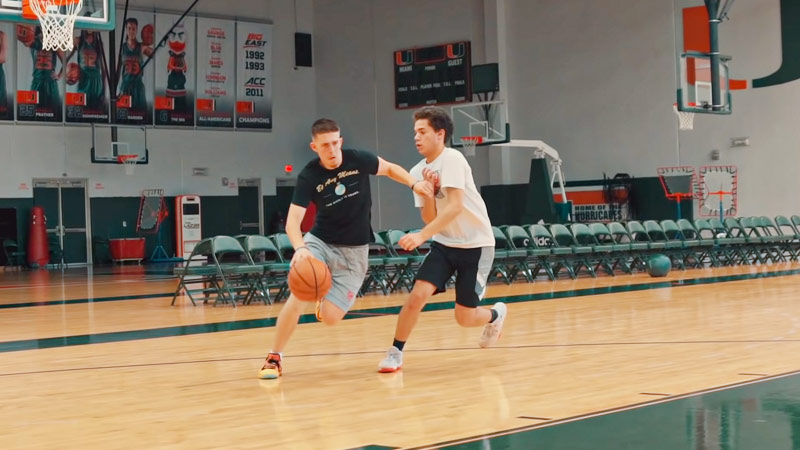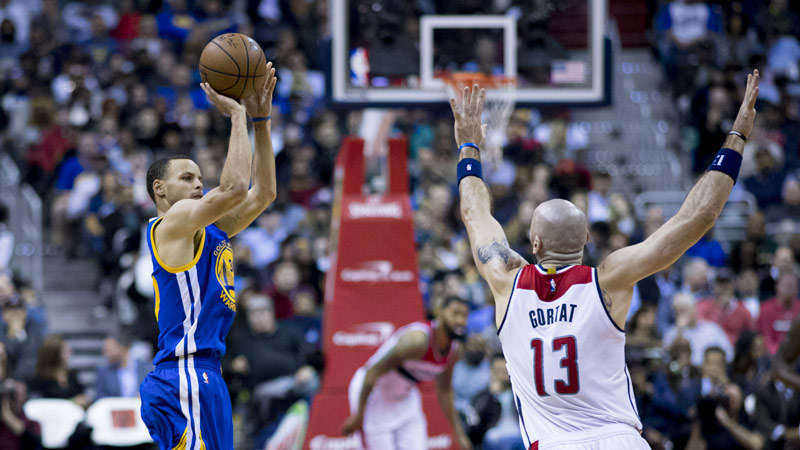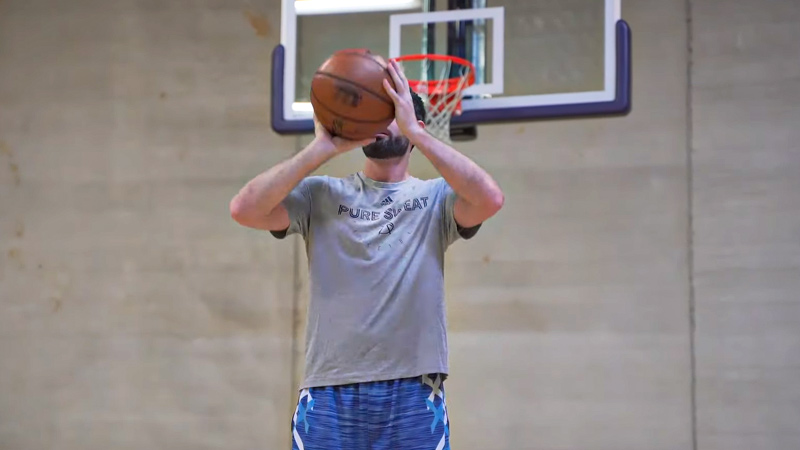We all know about the basketball court. But with all the energy of the play, some exclusive terminology can be helpful to you; such as the elbow in basketball.
Now Elbow in Basketball has two definitive terms – one for an extraordinary move in the play and another for elbow injury in basketball. It’s important to keep note of both.
After all, everything may go well unless there’s a basketball elbow injury to slow down the pace. Or, getting scored by the opponents while you have no idea of the elbow. However, elbow time may give you a hard time understanding.
Thus, if you are a practitioner or a pro, it is important to learn more about these terminologies with their different terms. Let’s get started.
Elbow in Basketball
It is a technique in basketball that often goes unnoticed. However, it delivers a significant impact on the players’ performance.
The elbow in basketball is a smart move; genuinely used for shooting, dribbling, passing, and more space. Also known as the chicken wing or the swing-through, the elbow involves using the elbow to create separation from defenders, gain shooting space, or execute powerful dribble moves.
What’s the secret behind this move?
The elbow trick in basketball offers players a quick thrust of force and changes the direction of their movement in an instant. It is the ultimate strategy when you are planning for the jab step, the step-back jumper, or the notorious rip-through move.
Understanding the Elbow
To develop a better idea of the elbow in basketball, it is important to learn about the critical parts of the basketball court. Here, we will break down different parts of the court and how it impacts the elbow in basketball.
Basketball Court
Here we are! Let’s begin with the different lines of the basketball court. They are a mandatory part of the play and cover different areas of the space.
Three-point Line:
Simply put, it’s the designated arc that covers the basket. It is a boundary, located 23 feet 9 inches away from the center of the basket in the National Basketball Association (NBA) and Fédération Internationale de Basketball (FIBA) tournaments.
However, when it comes to college basketball tournaments, the distance is slightly shorter at 22 feet 1¾ inches for men and 20 feet 9 inches for women.
Players make shots beyond this line and it counts as three points instead of the usual two points delivered inside the line.
The Key:
Move closer to the hoop and the rectangular near the basket is the key. It is also known as the paint. In fact, many call it the first throw lane or the restricted area.
The key in basketball is marked by two parallel lines. It extends from the baseline towards the free-throw line and a half-circle that connects the two lines on the baseline side.
The Perimeter:
The area between the three-point line and the key is the perimeter in basketball. It spreads beyond the three-point line and stops outside the key point.
Primarily, it is significant for the three-point field goal. It has a special term for the players who perform on the perimeter and they are called perimeter players. They are usually the guards or small forwards with agility and speed.
Free Throw Line:
Beyond these common terms, there is also a line a few feet down from the three-point line that goes around the top of the key. It is the free throw line.
From this designated arc, players make free throws. It is 15 feet away from the backboard and is perpendicular to the baseline. The line itself is 2 inches wide and extends across the width of the court.
The free throw line provides players with the opportunity to score without any interference from the opponent. Keep in mind that, free throws are generally the result of personal fouls, technical fouls, or other violations.
With free throws, teams can leverage the opponent’s mistake and earn points when the clock stops.
The Key Spot and The Elbow:

The elbow is not distinctly defined in the court. It is not a clear line like the three-point arc or the key point. So, what it is exactly?
The elbow in Basketball is essential in basketball and refers to a space in the court. Different teams use it in a different range of ways.
For example, the elbow can be a nice start for the offense to prepare. Midrange players also shoot from the elbow.
While moving across the basketball court, defense players keep the elbow in focus. They, in fact, have two players in at the top of the key point, standing one on each elbow.
Beside the corner of the key where the free throw line meets the lane line, is usually referred to as the elbow. A lot of actions happen here. Any player who gets the elbow first will have the upper hand.
When Do Players Use Elbow?
There was a time when the elbow was used often. It became popular in the early 20s.
It was then a part of the pick-and-roll offense; during this time, strong players used to take action from the triple-threat position.
However, people don’t simply use this trick anymore. Rather they focus on basic skills like shooting or passing primarily.
Another reason behind the fall of the Elbow can be the rise of three-pointers which reduced the value of this trick.
Teams don’t need the elbow to utilize the pick-and-roll strategy. They now can easily perform the trick from the three line.
This is why, players are often noticed around the three-line and away from the key. Now, players work around the elbow area rather than getting inside it.
Think about the players who built most of their careers finding out the elbow. Yes! A few of the center and forward players would seek the opportunity to pull up, drive down, or shoot the ball hard with the opening of the elbow.
Time passed by and they developed their skills for better adaption to the modern strategy of basketball. The elbow rule simply doesn’t work anymore.
Note:
Triple Threat Position: A position in basketball that allows the player to apply any of the three actions: (1) Dribble the Ball (2) Pass the Ball (3) Shoot the Ball.
It is a fundamental position where the player effectively takes advantage of scoring opportunities or makes one for their teammates.
Hey! We have also covered Basketball Basics for Beginners. Give it a peek.
Elbow Jump in Basketball

Source: wikipedia.org
Don’t confuse between elbow jump and elbow! The elbow is a specific space in the basketball court while the elbow jump is one kind of jump shot.
The Elbow Jump is performed near the elbow on the basketball court. It is a mid-range shot. The player’s shooting arm spreads vertically, with the elbow forming a 90-degree angle during this jump; hence the name “elbow jump.”
Players are placed around the free throw line or slightly closer to the baseline while performing this shot.
How To Do Elbow Jumping?
To score a basket, a player may try and attempt by jumping straight into the air. An elbow jumping will take place following these few conditions:
- The elbow of the shooting hand will be bent.
- The player who catches the ball will be facing the basket.
- The ball will be in the hand and above the head.
- The player would pass the ball in a high arc toward the basket.
Elbow Jumping may seem easy at first shot. But it needs the right shooting strategy, footwork, and proper knowledge about the opponent’s position.
The Jump Shot quickly became popular due to its ability to make shots from a distance that are difficult for the defenders to prevent. Thus it completely removed the earlier Set Shot and eventually improved the basketball game.
However, there are three variations to Jump Shots –
(1) Turnaround Jumper: Shooting in mid-air while away from the basket – then jumping and spinning towards it.
(2) Fadeway: Jumping away from the basket and making more space.
(3) Leaning Jumper: Players jump toward the basket to get away from the defender.
By mastering elbow jumping, you can introduce an entirely new angle to the offensive play; also offering effective ways to score more points.
You only need to remember to hone the elbow jumping, you will also need to develop a few other skills such as improving leg strength, bringing off the dribble, and many others.
Above all, balance is the key to delivering a successful Jump Shot. With practice and the right balance, elbow jumping can be the easy way to get more points.
Elbow Injury in Basketball
To put it shortly, elbow injuries in Basketball are a strain on the muscle due to overuse. It usually happens because of high pressure on the tendon that tethers the forearm muscle to the elbow.
Microscopic tears occur due to this and your elbow swells with inflammation and pain. Don’t overlook the symptoms. Elbow pain develops as a minor pain and gradually deteriorates.
Remember LeBron James??? He altered his shooting style after facing an elbow injury in 2017. Yeah! An elbow injury can be this serious.
Types of Elbow Injury in Basketball
At play, you can have elbow injury due to many reasons. Not all of them would be serious. But overlooking them may result in severe consequences.
The most common causes behind most elbow injuries are repetitive usage and carelessness.
For example, when you drop on your elbow and there is almost no padding on the joint, you will get badly hurt. This could have been avoided, you know!
However, the most common two types of elbow injuries in basketball are: (1) Elbow bursitis (2) Elbow tendinitis
- Elbow Bursitis: Other names are: elbow tendonitis and olecranon bursitis.
It happens when there is an inflammation in your elbow bursa (a thin, fluid-filled sac to support the bones and soft tissue).
Using your arm repetitively to throw or dribble the ball may often result in a pull or strain on your muscle.
Thus, your elbow will swell up and it will start to hurt badly.In the worst case, your muscle can tear up if you don’t remain under proper treatment. - Elbow Tendinitis: Mostly common in basketball players. Due to overuse of the forearm muscles, the elbow becomes swollen and inflammation happens.
Gradually, this leads to microscopic tears of the connecting tendons. Unlike Elbow Bursitis, it begins with a minor sensation and then the pain worsens.
Don’t confuse it with Elbow Tendonitis. It is Tendinitis, not Tendonitis 😉
Treatment of Elbow Injury?
Your primary response to any elbow injury is to ensure your elbow receives proper rest of the muscle. Later, followed by ice and more rest.
Generally, both Elbow Bursitis and Elbow Tendinitis require treatment depending on the state of the muscle. You may need NSAIDS and physical therapy to overcome the muscle strain.
Players with elbow injuries are recommended to rest for several days. They are issued a physical therapist who will help strengthen the muscle and tendons they need help with.
However, in severe cases, you might need to wear a splint to fully clamp your elbow.
Keep in mind that, prevention is better than cure. Don’t forget to warm up before getting on the court. It has been proved that warming up can reduce elbow injuries to a great extent.
Also, wear the right gear and warm up regularly to prevent serious elbow injuries.
Last Words on Elbow in Basketball
Here we are! At the end of our article. So, what do you think of the elbow in basketball?
The term elbow can be used differently in basketball. Sometimes as a playing strategy – the elbow, sometimes as one kind of jump shot, and sometimes as a form of injury.
It is important to get the meaning right and take action accordingly. If you are about to start your career in basketball, start here with us. Get a free platform to learn everything about basketball.
Don’t forget to share this article with your friends and help them know about basketball.







